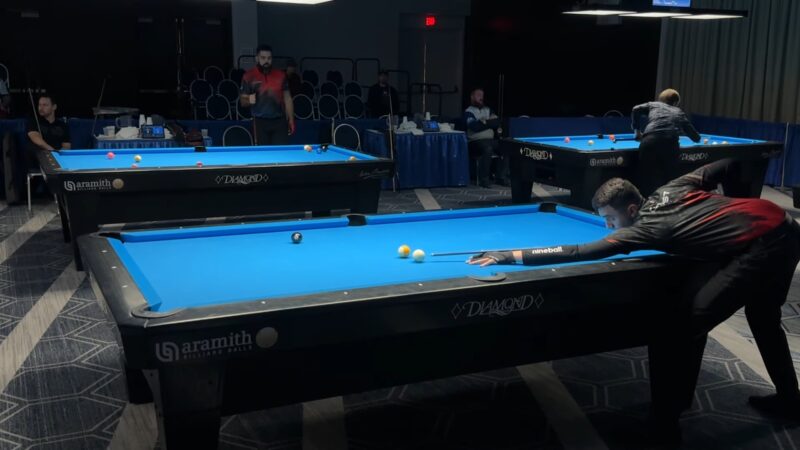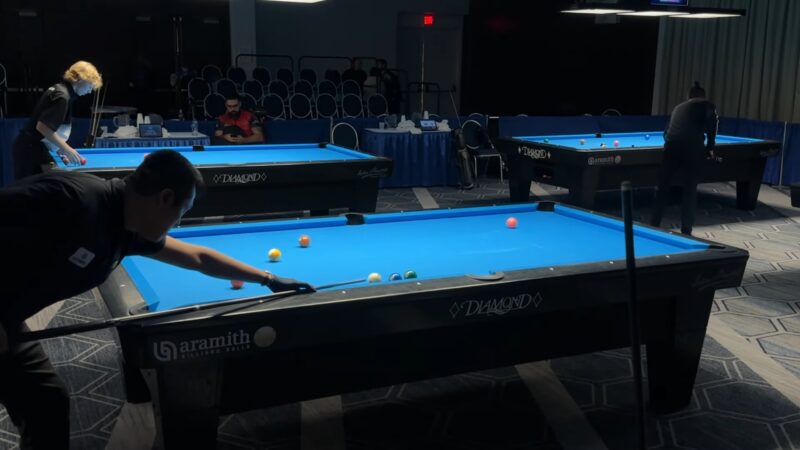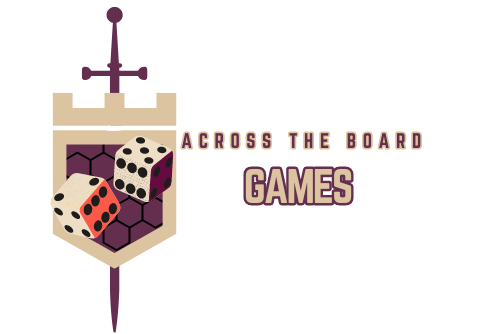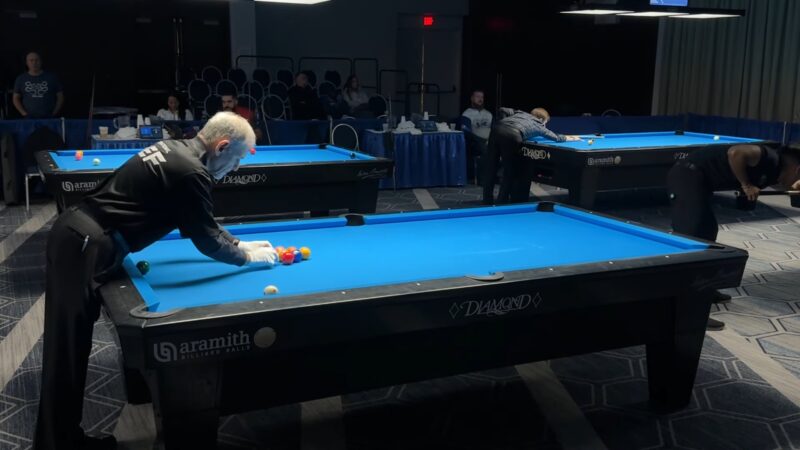9-Ball pool, a dynamic and strategic game, has roots that trace back to the early 20th century. It has since evolved into a popular cue sport, played by enthusiasts and professionals alike. This fast-paced game is known for its clear objectives and the skill it requires to master.
Unlike its cousin, 8-ball, 9-ball pool is often favored for its combination of luck and strategy, offering a thrilling experience for players of all levels. The game’s popularity has soared over the years, making it a staple in pool competitions and a favorite in bars and pool halls around the world.
Equipment and Setup
To play a 9-ball pool, you’ll need a standard pool table, cue sticks, a set of nine numbered balls plus the cue ball, and a rack. The balls are racked at the beginning of each game in a diamond shape using a special 9-ball rack, with the 1-ball positioned at the rack’s apex on the foot spot and the 9-ball placed in the center.
The other balls are placed randomly within the diamond. The setup is crucial as it dictates the initial layout of the game, influencing the break shot’s outcome.
The Objective of the Game

The main objective in a 9-ball pool is both clear-cut and compelling: to pocket the 9-ball for the win. Achieving this goal is not as straightforward as it might seem.
Players must take a strategic approach, targeting the balls in ascending numerical order, starting with the 1-ball and working their way up to the 9-ball.
While a player does not need to pocket every ball, they must always first contact the lowest-numbered ball on the table.
This rule adds layers of complexity and skill to the game, as players may set up for combination shots that pocket the 9-ball early or navigate through a rack to reach the game-winning shot.
Mastery of this objective requires not only precision and control but also foresight and tactical planning, making 9-ball a challenging and rewarding game for pool enthusiasts.
Basic Rules
The game begins with the break shot, which must be taken from behind the headstring. The breaker must strike the 1-ball first and either pocket a ball or drive at least four numbered balls to the rails.
A legal hit in 9-ball requires the cue ball to first contact the lowest-numbered ball on the table and either pocket a ball or drive any ball to the rail. Failure to meet these conditions results in a foul.
Fouls can lead to giving the opponent ball in hand, where they can place the cue ball anywhere on the table for their shot.
Game Play

In 9-ball pool, players take turns at the table, with each shot requiring the cue ball to first contact the lowest-numbered ball. A player continues shooting until they fail to legally pocket a ball.
After the break, the incoming player can opt for a “push out,” where they can shoot the cue ball anywhere without the need to hit the lowest-numbered ball or call a pocket. This strategic move can be used to escape difficult positions but must be declared before the shot.
Winning the game is straightforward: legally pocket the 9-ball after the lowest-numbered ball has been hit, and victory is yours.
Advanced Techniques and Strategies
Now, we want to explore strategies and techniques you can use to improve your game.
Power Breaking Techniques:
- Position the cue ball to maximize energy transfer.
- Use a closed bridge for a stable and powerful break.
- Aim for the 1-ball squarely to increase chances of pocketing a ball.
Ball Control and Spin:
- Apply side spin to control the cue ball’s path after contact.
- Use top and bottom spin to manage the cue ball’s speed and position.
Positional Play for Setting Up the Next Shot:
- Plan multiple shots ahead, considering the cue ball’s position.
- Practice cue ball control to land in optimal positions for subsequent shots.
Common Fouls and How to Avoid Them
Common errors should be avoided at higher skill levels. Here are some and how you can avoid them.
Cue Ball Fouls:
- Avoid double hits or “push shots” where the cue stick contacts the cue ball more than once.
- Do not let any part of your body touch the cue ball, which is a foul.
Object Ball Fouls:
- Ensure not to pocket the cue ball (“scratch”) when making a shot.
- Avoid hitting the wrong ball first, which is not in sequence with the game.
Tips for Playing a Clean Game:
- Always be aware of the ball order to avoid accidental fouls.
- Practice precision and control to minimize the risk of scratches.
Practicing 9-Ball Pool
Improving your 9-ball game requires focused practice. Start with drills that enhance your aim, such as shooting long straight shots or practicing hitting the cue ball at its center for accurate strikes.
Develop a consistent breaking routine by practicing your break shot from different positions to find the most effective angle and power.
Engage in strategy exercises by setting up common game scenarios and deciding the best course of action, which will help you make smarter decisions during actual gameplay.
Etiquette and Sportsmanship
Good sportsmanship is as important as skill in 9-ball pool. Respectful conduct includes acknowledging good shots by your opponent, avoiding distractions when it’s their turn, and handling disputes with grace.
If a disagreement arises over a rule or shot, it’s customary to pause the game and discuss the issue calmly or refer to a neutral third party for a decision.
Remember, the spirit of the game is maintained not just by playing well, but also by upholding the integrity and camaraderie of the sport.
FAQs
Are jump shots allowed in 9-ball pool?
Jump shots are typically allowed unless specific rules or local house rules prohibit them.
Can you accidentally win by pocketing the 9-ball on a non-break shot?
Yes, if you legally pocket the 9-ball on any shot after the break by first hitting the lowest-numbered ball, you win the game.
What should I do if there’s a dispute over a shot?
In casual play, it’s best to discuss and come to an agreement or redo the shot if there’s no referee. In tournament play, a referee’s decision is final.
Is there a specific way to hold the cue stick when breaking?
While personal style varies, a common method is to hold the cue stick firmly and use a closed bridge for a stable and powerful break shot.
The Bottom Line
Knowing the rules and strategies of 9-ball pool is essential to not only enjoy the game but also to excel at it. Whether you’re a casual player or aspiring to compete, mastering the nuances of 9-ball can be a rewarding challenge.
Remember, practice is key—so grab a cue, chalk up, and dive into the world of 9-ball pool, where every game is an opportunity to sharpen your skills and strategy.

